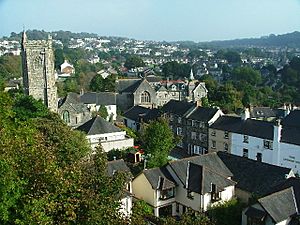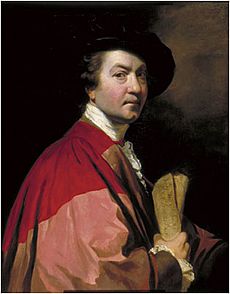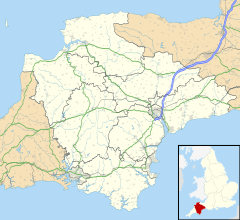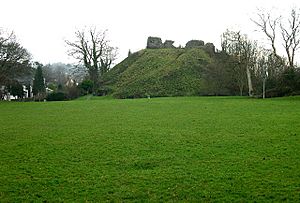Plympton facts for kids
Quick facts for kids Plympton |
|
|---|---|
 Looking down on part of the town from the castle |
|
| Population | 29,899 (2011 Census) |
| OS grid reference | SX542561 |
| Shire county | |
| Region | |
| Country | England |
| Sovereign state | United Kingdom |
| Post town | PLYMOUTH |
| Postcode district | PL7 |
| Dialling code | 01752 |
| Police | Devon and Cornwall |
| Fire | Devon and Somerset |
| Ambulance | South Western |
| EU Parliament | South West England |
| UK Parliament |
|
Plympton is a part of the city of Plymouth in Devon, England. It used to be an old "stannary town," which means it was a special place where tin from local mines was weighed and taxed. Plympton was also an important trading hub and a seaport. However, the River Plym eventually filled up with mud, making it hard for ships to reach. Because of this, trade moved further down the river to what is now Plymouth. For many centuries, Plympton Priory, a large religious house, owned a lot of land here.
Plympton is actually a mix of several old villages that grew together. These include St Mary's, St Maurice, Colebrook, Woodford, Newnham, Langage, and Chaddlewood.
Today, Plympton has a few primary schools and two secondary schools. Most of these schools are now "academy convertors," which means they are run independently from the local council.
Contents
What's in a Name?
The name Plympton might seem like it comes from the River Plym, but experts don't think that's true. The town isn't actually on the river. Instead, it sits on an old path called 'the Ridgeway' that leads from Dartmoor.
The oldest record of the name is "Plymentun" from around 900 AD. This name might come from an old English word, plymen, meaning "growing with plum-trees." So, Plympton could mean "Plum-tree farm." Another idea is that it comes from Cornish words for 'plum' or 'lead', possibly because of the tin mining.
Later, in the 1200s, the River Plym got its name from Plympton and a nearby place called Plymstock. This also led to the naming of Plymouth, the fishing port built at the river's mouth. Plymouth was originally called Sutton, but it was renamed when the river became too muddy for boats to reach Plympton.
A Look Back in Time
Close to Plympton, you can find Boringdon Camp, an old hill fort from the Iron Age. Plympton is mentioned in the Domesday Book of 1086, a famous survey ordered by King William the Conqueror. It recorded that the king owned Plympton, and it had 27 villagers, 12 small farmers, and 6 slaves.
In the early 1100s, an important priory (a type of monastery) was built in Plympton by William Warelwast. The monks there were called Augustinian canons. This priory quickly became the second richest religious house in Devon, after Tavistock. You can still see the gatehouse of the priory today. In 1872, it was noted that the gatehouse, kitchen, and dining hall were still in good shape.
King Henry I gave Richard de Redvers (who died in 1107) control of the Plympton area, which was centered around Plympton Castle. Richard was a very trusted supporter of the king. The de Redvers family later became important noblemen called Earls of Devon. Their lands, including Plympton, and their titles were later passed down to the Courtenay family.
The old stannary town is still dominated by its ruined Norman motte-and-bailey castle. It also keeps its old medieval street layout. Many historic buildings, made from local green Devon slate, limestone, and white-washed walls with Dartmoor granite details, show its long history.
Before the Reform Act 1832, Plympton was one of the "rotten boroughs." This meant it was a very small town but still got to send two Members of Parliament (MPs) to the unreformed House of Commons, even though it had very few voters.

The famous painter Sir Joshua Reynolds (1723–1792) was born and grew up in Plympton. He later became the first president of the Royal Academy of Arts. He was even the mayor of Plympton in 1773. His father was the headmaster of Plympton Grammar School, which is a historic building in the town center. Other famous students from the school included Benjamin Haydon and Sir Charles Lock Eastlake. Many of Reynolds' paintings were bought by his friends, the Parker family, who lived at the local Saltram House. These paintings are still on display there today.
Buildings and Design
Plympton has 68 buildings that are officially "listed" by Historic England. This means they are important historical buildings that are protected. One of them is a Grade I listed building (Plympton House, St Peter's Convent), which is the highest level of protection. Six are Grade II*, and 61 are Grade II.
Fore Street, the main street in town, has many medieval buildings. About thirty of these are either Grade II* or Grade II listed. The Grade II* buildings include The Old Rectory, the Guildhall, and Tudor Lodge.
Churches in Plympton
Plympton has two churches. The Church of St Thomas at Plympton St Maurice (also known as the Church of St Maurice) has parts that date back to Norman times.
St Mary's church was officially opened in 1311. It was originally a small chapel connected to Plympton Priory. It has two aisles on each side of the main part of the church, with the outer aisles being shorter. The tower, made of granite, can be seen from far away. The south porch has beautiful carvings and a special type of vaulted ceiling. The outer north aisle is the oldest part of the church, and most of the rest was built in the 1400s. Inside, you can find monuments to the Strode family, including a tomb for Richard Strode (who died in 1464) showing him in armor. There's also a monument for William Strode (who died in 1637) and his family, showing him, his two wives, and ten children.
Plympton Today
Between about 1990 and 2010, Plympton grew a lot as the population of Plymouth expanded. To help manage this growth, Plympton has been divided into different areas: Yealmpstone, Plympton-St Maurice, Colebrook, Underwood, Woodford, and Chaddlewood.
Community Council
Plympton has a Community Council, which was set up when the town became part of the Plymouth Local Authority in 1967. The Council is based at Harewood House. It's a group of volunteers who help coordinate and connect social, recreational, and community groups in Plympton.
The Community Council decided that a special resident should represent the town. This person would open events and attend civic gatherings as Plympton's representative. In 1980, the first modern "Stannator" was chosen for this role. More recently, a "Youth Ambassador" has also been elected to represent young people in Plympton and attend events with the Stannator.
The Stannator and Youth Ambassador are chosen for one year. They are officially given their roles at a ceremony at Harwood House on the third Saturday evening of April each year.
There have been 43 modern Stannators of Plympton:
| Year(s) | Name |
|---|---|
| 1980-81 | Mr W Harvey |
| 1981-82 | Mr W Jarvis |
| 1982-83 | Cllr J Stopporton |
| 1983-84 | Dr K Clapton |
| 1984-85 | Mr E Westlake |
| 1985-86 | Mrs M Lynden |
| 1986-87 | Mr J Currie |
| 1987-88 | Cllr A Wright |
| 1988-89 | Mrs W Smith |
| 1989-90 | Mr G Morris |
| 1990-91 | Mr K Yabsley |
| 1991-92 | Mrs D Sinstadt |
| 1992-93 | Mr J Boulden MBE |
| 1993-94 | Mrs P Burrows |
| 1994-95 | Preb J Richards |
| 1995-96 | Mrs K Roberts |
| 1996-97 | Mr J Pook |
| 1997-98 | Mr W Coleman |
| 1998-99 | Mrs M Easterbrook |
| 1999-00 | Mrs S Boulden JP |
| 2000-01 | Mr T Latter |
| 2001-02 | Mr J Willis |
| 2002-03 | Mrs M Knight |
| 2003-04 | Mrs U Griffiths |
| 2004-05 | Mrs N Chinner |
| 2005-06 | Mr F Mills |
| 2006-07 | Mr A C Street |
| 2007-08 | Mrs G Banfield |
| 2008-09 | Mr R T Coleman |
| 2009-10 | Mrs M Crabb |
| 2010-11 | Mr R W Shaw |
| 2011-12 | Mr F Lethbridge |
| 2012-13 | Mrs P Kadoche |
| 2013-14 | Mrs P Ridgeway |
| 2014-15 | Mrs S Luscombe |
| 2015-16 | Mr J Gilding |
| 2016-17 | Mrs R Hamley |
| 2017-18 | Mr A Hill |
| 2018-19 | Mrs N Harrison |
| 2019-22 | Mrs F Smith ARRC |
| 2022-23 | Pastor A Bassel |
| 2023-24 | Mr A Cooper |
| 2024-25 | Mr D Partridge |
There have been six Youth Ambassadors of Plympton:
| Year(s) | Name |
|---|---|
| 2017-18 | Mr Isaac Hudson |
| 2018-19 | Miss Molly Disney |
| 2019-22 | Miss Charlotte Bryant |
| 2022-23 | Miss Bel Winsor-Maloney |
| 2023-24 | Mr Oliver Chard |
| 2024-25 | Mr Christopher Turner |
Getting Around Plympton
Plympton has several main bus services. Routes 20A, 21, 21A, and 59 are run by Plymouth Citybus, and service 52 is run by Stagecoach Southwest.
In the past, Plympton had a railway station. It was first used for goods by the horse-drawn Plymouth and Dartmoor Railway. This line was later sold to the South Devon Railway, which built a line from Exeter to Plymouth. A station opened in Plympton on June 15, 1848. It was closed to passengers on March 3, 1959, and for goods in June 1964.
Besides the main railway, there's also The Plym Valley Railway. This is a preserved railway based at the rebuilt Marsh Mills station. It used to be part of the Great Western Railway line from Plymouth to Launceston. Volunteers are working to rebuild the line between Marsh Mills and Plymbridge. You can ride steam and diesel trains on many Sundays throughout the year.
Plymouth City Council has said it would like to reopen a train station in Plympton on the main line to London. This would provide quick and frequent trains into Plymouth. However, there are big challenges to doing this on a line mostly used for long-distance travel. A study in 2017 looked into it, and a plan called 'Plymouth Metro' was suggested in 2018, which included a station at Plympton. As of May 2020, nothing has been built yet.
Schools in Plympton
Plympton has two state secondary schools for students aged 11–18: Plympton Academy and Hele's School. These schools welcome students from Plympton and nearby areas like Laira, Ivybridge, and Dartmoor.
Sports Teams
Plympton Athletic F.C. is an amateur football club. As of 2020, they play in the Devon Football League South and West Division. Their home ground is the Lee Moor Stadium.
Plympton Victoria Rugby Club is the local rugby team.
Local Events
Plympton has hosted an annual festival called 'The Lamb Feast' for many years on the local Castle Green. This event is a key part of Plympton's Midsummer Festival in mid-June. The Lamb Feast and other activities happen over the weekend and are organized by the Plympton Civic Association.
Famous People from Plympton
- Elizabeth Johnson, a writer of religious pamphlets, was born in Plympton in 1721.
- Sir Joshua Reynolds, the famous painter, was born in Plympton.
- Paul Rogers, an actor, was born in Plympton.
- David Owen, who used to be the Foreign Secretary (a top government official dealing with other countries), was born in Plympton.
- Dorothy Perkins, the world-famous seamstress and fashion designer, was born and grew up in Plympton. She opened her first fashion shop in the co-op on the Ridgeway in 1731.



